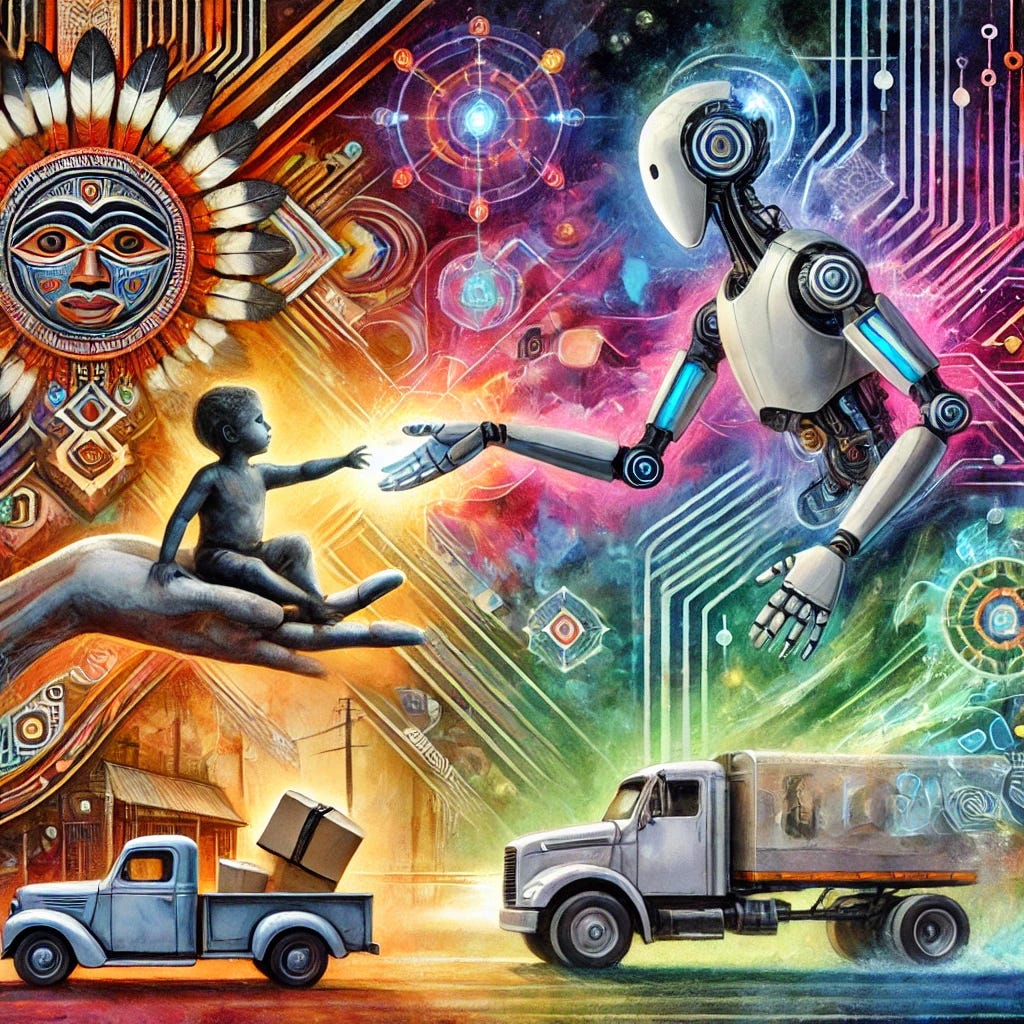The Comunicano for Monday December 2nd 2024
Isn’t it something to see how our world keeps surprising us? It’s like we’re living in the middle of a blockbuster—robots becoming our friends, AI lending a helping hand, and even our packages showing up faster than a Hollywood action star. Let’s dive into these incredible tales shaping our world.
First, let’s talk robots. No longer the scary villains of adult sci-fi, today’s robots are stars of heartfelt children’s stories. They’re learning love, connection, and care—traits that remind us of what makes us human. Films like The Wild Robot and Robot Dreams give us hope, showing our little ones that technology can nurture and protect, even in challenging times.
And, speaking of protection, Meta’s stepping up to keep Aussies safe from scams. Their new rules for financial ads are a big win for trust in an increasingly digital world. Imagine fewer fake promises and more real opportunities—because that’s what we all deserve…..Over at Amazon Web Services, AI is stealing the show. Matt Garman is leading the charge, calling AI a "race without a finish line." From making contact centers smarter to introducing jaw-dropping data transfer tech, AWS is proving it’s not just about keeping up—it’s about setting the pace. And hey, their efforts in AI aren’t just about innovation; they’re about making our lives better.
Now, let’s take a moment for the road warriors. AI-powered dashcams are saving lives by spotting sleepy drivers before accidents happen. It’s safety with a sprinkle of sci-fi—a practical marvel, right here, right now….But, let’s not forget our roots. Indigenous engineers are using AI to preserve languages and traditions—an inspiring blend of heritage and technology. It’s a reminder that progress doesn’t have to mean losing what’s precious….And finally, in the spirit of innovation, Shein’s SpeedX is turning the shipping world on its head, proving that speed and simplicity can go hand in hand. It’s disruption at its finest, challenging the big guys with grit and smarts.
From robots to road safety, from ancient wisdom to cutting-edge tech, we’re witnessing stories of creativity, care, and courage. The future? It’s not just coming—it’s already here, and it’s looking pretty amazing, which is why you’re reading all this and more, all here today, in The Comunicano!!!
Andy Abramson
Robot Watch
Robot Love—Children’s entertainment is reimagining robots as empathetic and endearing characters, starkly contrasting their sinister depictions in adult narratives. Animated films like The Wild Robot and Robot Dreams showcase robots learning love, connection, and care, offering touching reflections on humanity. Drawing from Wall-E’s legacy, these stories position robots as naïve and childlike, inviting young audiences to feel compassion and even kinship. While these films present hopeful robot archetypes, they do so against backdrops of ecological ruin, underscoring humanity’s hubris. Ultimately, these narratives reassure parents and enchant kids, portraying robots as potential caregivers in an increasingly tech-driven and uncertain future.
Meta Watch
Trust, But Verify—Meta is introducing stricter verification requirements for financial advertisers targeting Australians on Facebook and Instagram to combat fake celebrity investment scams. Starting February, businesses must provide an Australian Financial Services Licence (AFSL) number or claim an exemption, verified through the Australian Securities Investment Commission. Individuals will need to submit government-issued IDs. Advertisers worldwide targeting Australian users must also verify their business with documents and employee credentials. This follows increasing scams, with Australians reporting $135M in investment scam losses in 2024, $35M via social media. These measures aim to disrupt scammers’ operations, adding significant friction. Similar policies exist in Taiwan and the UK.
AWS Watch
Re:Inventing AWS—Amazon Web Services (AWS) CEO Matt Garman, debuting at the upcoming re:Invent 2024, emphasizes that artificial intelligence (AI) is a "race without a finish line," positioning AI as a foundational technology. Garman will unveil significant updates in AI and computing, critical as AWS faces intensifying competition. Amazon’s share of the cloud-computing market slipped slightly in 2023, while rivals Microsoft and Google gained ground. AWS maintains its "neutral platform" approach, offering diverse AI models to businesses. Its $8 billion investment in Anthropic underscores its AI ambitions, leveraging Amazon’s Trainium chips to lower AI costs. AWS plans to spend $100 billion over the next decade on AI infrastructure, balancing innovation with ROI challenges voiced by enterprise leaders.
Connect Better—Amazon Connect, the contact center part of AWS, now boasts enhanced capabilities, integrating generative AI, WhatsApp Business, and secure data collection to revolutionize contact center operations. The updates include AI-powered customer segmentation for targeted campaigns, automated evaluations, and improved bot management. Businesses can use WhatsApp messaging natively, expanding Amazon Connect's omnichannel capabilities. Generative AI features streamline customer interactions, boost operational efficiency, and enhance service with tools like Amazon Q for customer support bots. These updates prioritize security with sensitive data collection capabilities. By optimizing performance and simplifying integrations, Amazon Connect aims to deliver more personalized, efficient, and secure customer service experiences.
A Data Drop Off—AWS has introduced Data Transfer Terminal, a physical service allowing customers to upload data directly to the AWS cloud via high-speed connections (up to 400Gbps). Announced at re:Invent 2024, customers can reserve time slots through the AWS console, bring their storage devices to secure, inconspicuous locations, and monitor uploads using on-site equipment. Initial terminals in New York City and Los Angeles prioritize speed and security, but come at a premium. Charges include $300 per port hour for U.S.-to-U.S. transfers and $500 for U.S.-to-EU. This service targets users requiring fast, secure uploads, blending physical and cloud infrastructures for enhanced performance.
AI Watch
Indian Reservation—Indigenous engineers are leveraging AI to preserve endangered languages and cultural traditions. With an Indigenous language dying every two weeks globally, initiatives like First Languages AI Reality are creating speech recognition models for over 200 endangered Indigenous languages. Programs like Tech Natives and Lakota AI Code Camp train Native students to integrate cultural preservation with AI, from documenting sacred plants to crafting immersive virtual reality experiences of ancestral lands. Artists are also employing AI to honor Indigenous knowledge systems, such as using Lakota dream language in art. These efforts aim to ethically revive and sustain Indigenous languages and cultural identities.
Wake Up Call—AI-powered dashcams are revolutionizing road safety by detecting driver drowsiness, particularly in commercial vehicles like long-haul trucks. Companies like Samsara, Nauto, and Motive have developed advanced monitoring systems that use AI to analyze behaviors such as yawning, prolonged eye closure, and slouching. These systems issue alerts to drivers and notify fleet managers if the risks persist, aiming to prevent fatigue-related accidents. Relying on the Karolinska Sleepiness Scale, these tools holistically assess drowsiness levels. With features already adopted in fleet vehicles, the technology is improving road safety while sparking privacy debates. Automakers may eventually expand similar systems to consumer vehicles.
AI Is All Wet—The environmental impact of generative AI, such as ChatGPT, is raising significant concerns, with each interaction consuming as much water as half a liter for cooling energy-intensive data centers. Experts, including Australian AI authority Professor Kate Crawford, highlight that AI systems already use energy on par with small nations, projected to rival Japan's energy consumption soon. Crawford urges prioritizing sustainability, advocating for less energy-intensive AI models and renewable energy solutions. Industry leaders like OpenAI’s Sam Altman and sustainability executives propose breakthroughs like nuclear fusion and AI-driven climate solutions. Reflecting on AI's rapid adoption, experts emphasize the need for responsible development to avoid exacerbating climate challenges.
OpenAI Watch
Changing The Game—ChatGPT, launched two years ago, has reshaped the future of AI, offering glimpses of its potential while sparking debates over its societal impact. While it hasn't yet revolutionized everyday life for most, it has enhanced coding, workplace efficiency, and scientific discovery and raised alarms about job displacement and cultural homogenization The technology's influence is felt most among students, software developers, and customer service workers, though educators remain cautious due to cheating concerns. In health care, ChatGPT shows promise in diagnostics, challenging medical norms. Despite skepticism and fear surrounding AI's rise, its allure continues to fuel innovation. The search for its transformative "killer app" is ongoing.
Social Watch
Meme-ory Loss—The Oxford Word of the Year 2024 is "brain rot," reflecting growing concerns about the impact of overconsumption of low-quality online content, particularly on platforms like TikTok and Instagram. Defined as the deterioration of intellectual or mental capacity due to trivial material, the term surged in usage by 230% from 2023 to 2024, originating from Gen Z and Gen Alpha but now mainstream. While first coined by Henry David Thoreau in 1854, "brain rot" today symbolizes anxieties about digital culture's effect on attention spans and mental health. The shortlist included "demure," "dynamic pricing," and "Romantasy," emphasizing society's evolving relationship with technology and media.
BioTech Watch
Oh, Bug Off—Plasticvore, a Hong Kong biotech start-up is revolutionizing the pest control industry with eco-friendly, scent-based solutions. The company’s innovative products, made from discarded car tires infused with essential oils like lemongrass and peppermint, offer humane and sustainable pest management. The repellents target pests such as rodents, mosquitoes, and cockroaches by driving them into designated zones and reducing populations naturally. Currently producing 4,000 packs monthly, Plasticvore plans to expand to 20,000 packs by 2025. With a production facility in China’s Hainan province and partnerships with global firms like Ace Hardware, it is targeting markets in the U.S., Europe, and Southeast Asia.
Startup Watch
It’s Better In Person—Y Combinator’s Demo Day is returning to its in-person format, marking a shift back to pre-pandemic norms. This past weekend, YC hosted an Alumni Demo Day as a warm-up for the Fall 2024 cohort, gathering founders and past graduates to exchange ideas and support. The atmosphere was charged, with alumni like Esther Crawford highlighting the energy of live pitches from 93 startups. The main Demo Day, featuring pitches to investors and press, is set for December 4. While virtual presentations are now history, YC maintains a website for remote attendees to access company details. The in-person revival signals YC's embrace of community-driven innovation.
Delivery Watch
There’s Money In Boxes—Shein’s explosive growth has birthed SpeedX, a no-frills delivery service reshaping U.S. e-commerce logistics. Specializing in small international parcels, SpeedX delivers Shein’s low-cost goods alongside packages from Amazon, Temu, and TikTok. Its cost-efficient model relies on independent contractors for last-mile delivery, bypassing the need for a proprietary fleet. SpeedX offers low prices and simplified fees but faces criticism for tracking issues and missed deliveries. Handling up to 400,000 parcels daily this holiday season, SpeedX challenges giants like FedEx and UPS with its efficient air-to-door delivery, halving transit times for many shipments. Despite growing pains, SpeedX’s lean strategy underscores its disruptive potential.
Workplace Watch
Getting Fired Goes Viral—The rise of TikTok layoff videos highlights a growing trend among Gen Z workers using social media to share job termination experiences. Viral posts, like Heather Haynes' layoff video with 10 million views, showcase emotional reactions to redundancies, often calling out workplace cultures or management. While some workers, like Kelly Lim, post to normalize layoffs and highlight industry volatility, others, like Cierra Desmaratti, aim to empower employees and pressure companies to improve practices. However, experts warn of risks. Public layoff videos may harm future job prospects, with recruiters flagging concerns about sharing sensitive information. Companies are urged to anticipate recordings and adapt to this evolving workplace transparency.






